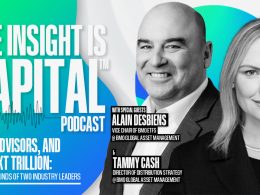by Ben Carlson, A Wealth of Common Sense
“Because people play an important role in determining the course of the financial markets, stock prices move like a manic-depressive.” – Howard Marks
It looks like trading by individual investors is making a comeback. According to the Wall Street Journal, TD Ameritrade, E*Trade and Charles Schwab have all posted huge gains in trading volume to start the year and it’s coming from the average investor:
Executives attributed the growth to strong returns from stocks in recent years, more widespread adoption of mobile-trading technology and the lack of alternatives to stocks in a period of historically low interest rates. More market volatility during the first quarter added to trading volume, executives said.
Broader stock-market volume has been sluggish, suggesting ordinary people are accounting for an increasing percentage of overall stock-market activity.
It’s amazing how a combination of large gains in the recent past and some choppiness this year can bring out the inner day trader in people. When markets move in one direction for an extended period, as they did in 2013, investors begin to see patterns where none exist. Jason Zweig touched on this in his book, Your Money & Your Brain, to show how this sort of behavior is ingrained in our brain activity:
After two repetitions of a stimulus – like say, a stock price that goes up one penny twice in a row – the human brain automatically, unconsciously, and uncontrollably expects a third repetition.
Patterns and trends do matter in the markets. There’s no disputing that. The problem for most investors is when the patterns they see get extrapolated out into the future indefinitely. So coming into 2014, after enormous gains in 2013, investors expected more of the same from stocks. When that didn’t happen, investors decided they needed to trade more because of a perceived increase in volatility. More from Zweig on why this occurs:
Once people conclude that an investment’s returns are “predictable,” their brains respond with alarm if that apparent pattern is broken.
One of the most important aspects of investing that most people don’t understand is that financial markets are always and forever cyclical. The trend has always been higher, but nothing grows to the sky. And when we have a downturn, markets don’t go to zero.
This is why many investors lose control when things don’t go as planned. When things are going well we get used to it. We get comfortable. That’s why the first four months of 2014 have proven so frustrating for most investors. The market has fluctuated, but it hasn’t taken off or crashed. There hasn’t been the binary movement.
Because of their portfolio positioning or general outlook on the markets, nearly every investor is bullish or bearish at all times. There aren’t many neutral investors (I consider holding cash with long-term capital to be bearish since it’s a loser to inflation over time). That means no one is happy in a sideways market because both sides end up being wrong in their stance.
Maybe the market takes off from here or has the correction so many have been waiting for. I don’t know. But if we continue to see a sideways, choppy market that keeps everyone unsatisfied try to think about it like playing offense against a 2-3 zone in basketball – stay patient and don’t force anything.
Sources:
Mom and Pop Step Up Their Trading (WSJ)
Subscribe to receive email updates and my monthly newsletter by clicking here.
Follow me on Twitter: @awealthofcs
Copyright © A Wealth of Common Sense











